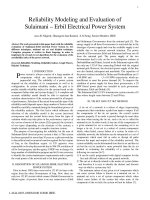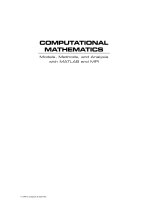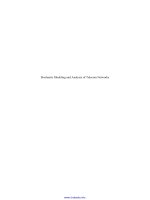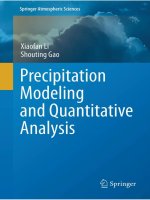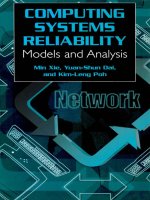Reliability modeling and analysis with mean residual life
Bạn đang xem bản rút gọn của tài liệu. Xem và tải ngay bản đầy đủ của tài liệu tại đây (1.72 MB, 194 trang )
RELIABILITY MODELING AND ANALYSIS WITH
MEAN RESIDUAL LIFE
SHEN YAN
(B.Sc., University of Science and Technology of China)
A THESIS SUBMITTED
FOR THE DEGREE OF DOCTOR OF PHILOSOPHY
DEPARTMENT OF INDUSTRIAL & SYSTEMS ENGINEERING
NATIONAL UNIVERSITY OF SINGAPORE
2009
Acknowledgements
I
ACKNOWLEDGEMENTS
First and foremost I offer my sincerest gratitude to my main supervisor, Professor Xie
Min, who has supported me throughout my PhD research with his patience and
knowledge whilst allowing me the room to work in my own way. His genius and
passion in research has made him as a great advisor who will be always respected and
influence my future life. I am indebted to his supervision and help more than he
knows.
I am also heartily thankful to Professor Tang Loon Ching, my co-supervisor,
for his guidance and very helpful suggestions on my research. His insightfulness has
greatly benefited me during my research study. His critical comments have triggered
and nourished my intellectual maturity; and also have promoted and enriched my
research ability. I am really grateful to his directions.
I would like to thank Dr. Ng Szu Hui and Dr. Wikrom Jaruphongsa, who
served for my oral examination committee and provided me comments on my
research and thesis writing. More thanks go to Dr. Ng Szu Hui who helped me a lot in
teaching and tutorials. I also gratefully thank Ms. Ow Lai Chun and Mr. Lau Pak Kai
Acknowledgements
II
for their excellent administrative and technical support to my PhD study. Moreover, I
would like to thank the National University of Singapore and the Department of
Industrial and Systems Engineering for offering a Research Scholarship to me, so that
I could successfully complete my research and gain overseas research experience.
It is a pleasure to pay tribute also to the members in Quality and Reliability
Engineering Laboratory, past and present, for their friendship and help throughout my
research. With all of them, I have experienced a wonderful and memorable post-
graduate life. Thanks go in particular to the sample senior, Zhou Peng, who gave me
great helps in research and thesis writing. I would also like to thank Wei Wei and
Xiong Chengjie for their help in dealing with teaching assistant duties. It is my honor
to be together with Li Yanfu, Qian Yanjun, and Zhang Haiyun for attending classes
and doing research in the same group.
I convey special acknowledgement to Professor Hu Taizhong at Department of
Statistics and Finance, University of Science and Technology of China. He is my
bachelor thesis supervisor. He also gave valuable suggestions and helpful discussions
for my PhD research.
Finally, I thank my mother for supporting me throughout all my studies at
university and for providing a home in which I could restore my courage when I feel
upset. I am extraordinarily fortunate in living with my great-grandmother,
grandmother, and grandfather. Furthermore, to Wu Yunlong and his family, thank you.
Table of Contents
III
TABLE OF CONTENTS
ACKNOWLEDGEMENTS I
SUMMARY VII
LIST OF TABLES XI
LIST OF FIGURES XIII
LIST OF NOTATIONS XVII
CHAPTER 1 INTRODUCTION 1
1.1
BACKGROUND INFORMATION 1
1.2
RESEARCH MOTIVATION 4
1.3
RESEARCH SCOPE AND OBJECTIVE 8
1.4
ORGANIZATION OF THE THESIS 9
CHAPTER 2 LITERATURE REVIEW 13
2.1
DEFINITIONS AND PROPERTIES 13
2.1.1 Basic definitions and concepts 14
2.1.2 Mean residual life classes 16
2.1.3 Properties and relations with failure rate function 21
2.2
RELIABILITY MODELING 27
2.2.1 Parametric models 29
2.2.2 Nonparametric estimation 36
2.3
MEAN RESIDUAL LIFE OF SYSTEMS 39
2.4
SOME APPLICATIONS 43
CHAPTER 3 A GENERAL MODEL FOR UPSIDE-DOWN BATHTUB-
SHAPED MEAN RESIDUAL LIFE 47
3.1
INTRODUCTION 47
3.2
A GENERAL FRAMEWORK 49
Table of Contents
IV
3.3 THE UBMRL MODEL 52
3.3.1 Construction of the model 52
3.3.2 Derivation of (3.2) and (3.3) 53
3.3.3 Failure rate function and other functions 55
3.3.4 Shapes and changing points of MRL and failure rate functions 56
3.3.5 Parameter estimation 59
3.4
TWO APPLICATION EXAMPLES 61
3.4.1 Example 3.1 61
3.4.2 Example 3.2 64
3.5
MODEL APPLICATION IN DECISION MAKING 67
3.6
NONLINEAR REGRESSION METHOD BASED ON THE MRL 70
3.7
CONCLUSION 73
CHAPTER 4 DECREASING MEAN RESIDUAL LIFE ESTIMATION
WITH TYPE II CENSORED DATA 75
4.1
INTRODUCTION 75
4.2
A METHODOLOGY BASED ON EMPIRICAL FUNCTIONS 78
4.2.1 The empirical MRL function 78
4.2.2 Two estimators of the reliability function 79
4.2.3 Proofs of Proposition 4.1 and 4.2 82
4.2.4 A estimation procedure to estimate mean time to failure and the MRL 85
4.3
SIMULATION STUDY 89
4.3.1 Estimation results 89
4.3.2 Comparisons between the new and some parametric methods 90
4.4
CONCLUSION 93
CHAPTER 5 RELATIONSHIP BETWEEN MEAN RESIDUAL LIFE AND
FAILURE RATE FUNCTION 95
5.1
INTRODUCTION 95
5.2
FROM FAILURE RATE FUNCTION TO MRL 97
5.2.1 Some results on MRL due to the change of failure rate function 98
5.2.2 Numerical examples and practical implication 103
5.3
FROM MRL TO FAILURE RATE FUNCTION 108
5.3.1 Some results on failure rate function for ordered MRL 108
5.3.2 The application in estimating bounds for failure rate function 111
5.3.3 Simulation results and sensitivity analysis 113
5.4
CONCLUSION 120
CHAPTER 6 CHANGE POINT OF MEAN RESIDUAL LIFE OF SERIES
AND PARALLEL SYSTEMS 121
6.1
INTRODUCTION 122
6.2
DEFINITIONS AND BACKGROUND 123
6.2.1 MRL of series system 124
6.2.2 MRL of parallel system 125
6.3
THE CHANGE POINTS OF MEAN RESIDUAL LIFE OF SYSTEMS 126
6.3.1 The change point of the MRL for series systems 127
Table of Contents
V
6.3.2 The change point of the MRL for parallel systems 130
6.3.3 Proof of Theorem 6.2 134
6.4
AN ILLUSTRATIVE EXAMPLE AND APPLICATION 139
6.4.1 An example 139
6.4.2 Some practical applications 141
6.5 P
ARALLEL SYSTEM WITH TWO DIFFERENT COMPONENTS 144
6.5.1 Exponential distributed component 144
6.5.2 UBMRL type component 146
6.6
CONCLUSION 149
CHAPTER 7 CONCLUSIONS AND FUTURE RESEARCH 151
7.1
SUMMARY OF RESULTS 151
7.2
POSSIBLE FUTURE RESEARCH 153
BIBLIOGRAPHY 159
Summary
VII
SUMMARY
Mean residual life (MRL), representing how much longer components will work for
from a certain point of time, is an important measure in reliability analysis and
modeling. It offers condensed information for various decision-making problems,
such as optimizing burn-in test, planning accelerated life test, establishing warranty
policy, and making maintenance decision. Realizing the importance of the mean
residual life, this thesis focuses on the modeling (Chapter 3 and Chapter 4) and
analysis (Chapter 5 and Chapter 6) based on this characteristic.
This thesis studies both parametric models and nonparametric methods, which
are the two common ways in reliability modeling. In Chapter 3, a parametric model is
developed for a simple, closed-formed upside-down bathtub-shaped mean residual life
(UBMRL). This model is derived from the derivative function of MRL, instead of
reliability function and failure rate function that are often used in model construction.
We first characterize the derivative function and develop a general form for the model.
Based on the general form, a suitable function is selected as a starting point of the
derivation of the new UBMRL model. The MRL function and the failure rate function
Summary
VIII
are further studied. Numerical examples and comparisons indicate that the new model
performs well in modeling lifetime data with bathtub-shaped failure rate function and
UBMRL function.
Besides the parametric model, we propose a nonparametric method for the
estimation of decreasing MRL (DMRL) with Type II censored data (Chapter 4). This
method is based on the comparison between two estimators of the reliability function,
the Kaplan-Meier estimator and an estimator derived from the empirical MRL
function. Based on data generated from Weibull and gamma distributions, simulation
results indicate that the new approach is able to give good performance and can
outperform some existing parametric methods when censoring is heavy.
Moreover, the analysis of the relationship between MRL and other reliability
measures is another important issue. Hence, Chapter 5 focuses on the relations
between MRL and the failure rate function by studying the effect of the change of one
characteristic on the other characteristic. The range that the MRL will decrease
(increase) if the associated failure rate function is increased (decreased) to a certain
level is investigated. On the other hand, the difference of two failure rate function is
also studied in the case that their corresponding MRL functions are ordered. Some
inequalities are established to indicate upper or lower bound on the extent of change.
The application of the inequalities is also discussed.
As an extension of the MRL of single items that is discussed in foregoing
chapters, the MRL of systems is investigated in Chapter 6. We discuss MRL of series
and parallel systems with independent and identically distributed components; and
obtain the relationships between the change points of MRL functions for systems and
Summary
IX
for components. Compared with the change point for single components assuming
that it exists, the change point for a series system occurs later. For a parallel system,
its change point is located before that for the components, if it exists at all. Moreover,
for both types of systems, the distance between the change points for systems and for
components increases with the component number. In addition, the MRL of a parallel
system with two non-identical components is briefly discussed in a graphic way.
List of Tables
XI
LIST OF TABLES
Table 3.1 Lifetimes of 50 devices from Aarset (1987). 61
Table 3.2 The estimated parameters and AIC values of different models. 63
Table 3.3 Time to failure of 18 electronic devices from Wang (2000) 65
Table 3.4 The estimated parameters and AIC values of different models. 66
Table 3.5 Mean squared errors for nonlinear regression estimation and MLE 73
Table 4.1 The function )(
⋅
h for different censor degrees. 88
Table 4.2 Simulation results for Weibull distribution with shape and scale
parameters ),(
α
β
. 92
Table 4.3 Simulation results for gamma distribution with shape and scale
parameters ).,( ab 93
Table 6.1 Net profits for different component numbers. 143
List of Figures
XIII
LIST OF FIGURES
Figure 2.1 Typical curves of UBMRL and BFR. 19
Figure 2.2 Scaled TTT transform for different distribution classes. 28
Figure 3.1 A desired shape of the derivative of MRL function )(tm
′
. 49
Figure 3.2 Example UBMRL functions. 57
Figure 3.3 Example BFR functions 57
Figure 3.4 The failure rate function for the model (bold line) and the empirical
failure rate function (jagged line) 62
Figure 3.5 The failure rate function plot based on different models in Table 3.2. 64
Figure 3.6 The MRL function for the new model in Table 3.2 64
Figure 3.7 The failure rate function for the model (bold line) and the empirical
failure rate function (jagged line) 65
Figure 3.8 The failure rate function plot based on different models in Table 3.4. 66
Figure 3.9 The MRL function for the new models in Table 3.4. 67
Figure 3.10 The fitted MRL by nonlinear regression (solid line) and MLE (grey
line). 72
Figure 4.1 The curves of three possible reliability functions under censorship 77
List of Figures
XIV
Figure 4.2
The behaviors of )(
~
)(r
tR with respect to
μ
)50,10( =
=
nr 81
Figure 4.3 Comparison between real MRL (bold line) and estimated MRL
function: Weibull distribution (2, 1) with censor degree of 0.4 90
Figure 4.4 Comparison between real MRL (bold line) and estimated MRL
function: gamma distribution (4, 10) with censor degree of 0.7 90
Figure 5.1 The plots of the MRL and the failure rate function for
1
T
,
2
T
in
Example 5.1. 105
Figure 5.2 The plots of the MRL and the failure rate funcitons for
21
, TT in
Example 5.2. 106
Figure 5.3 The plotting of the empirical MRL function and the MRL functions of
1
T and
2
T for DMRL class 114
Figure 5.4 The plotting of the real failure rate function and the estimated upper
bound and lower bound for DMRL class 114
Figure 5.5 The plotting of the empirical MRL function and the MRL functions of
1
T
and
2
T
for IMRL class. 115
Figure 5.6 The plotting of the real failure rate function and the estimated upper
bound and lower bound for IMRL class. 116
Figure 5.7 Parallel MRL and the associated failure rate functions. 117
Figure 5.8 MRL with the same value at time 0 and the associated failure rate
functions 118
Figure 5.9 MRL with the same value at time
)(n
t
and the associated failure rate
functions 119
List of Figures
XV
Figure 6.1
The plotting of the MRL of components (bold line) and the MRL
function of series system with
n components. The solid circles mark
the locations of the change points 140
Figure 6.2 The plotting of the MRL of components (bold line) and the MRL
function of parallel system with
n components. The solid circles mark
the locations of the change points 140
Figure 6.3 The plotting of the MRL of components (bold line) and the generalized
MRL of parallel system with
n components. The solid circles mark the
locations of the change points 141
Figure 6.4 Locations of
0
t for different
1
λ
and
2
λ
146
Figure 6.5 Change point for parallel systems with parameter a – modified Weibull
distribution. 148
Figure 6.6 Change point for parallel systems with parameter b – modified Weibull
distribution. 148
Figure 6.7 Change point for parallel systems with parameter λ – modified Weibull
distribution. 149
List of Notations
XVII
LIST OF NOTATIONS
MRL Mean Residual Life
IMRL Increasing Mean Residual Life
DMRL Decreasing Mean Residual Life
IDMRL Increasing and then Decreasing Mean Residual Life
UBMRL Upside-down Bathtub-shaped Mean Residual Life
BMRL Bathtub-shaped Mean Residual Life
NBUE New Better than Used in Expectation
NWUE New Worse than Used in Expectation
NWBUE New Worse then Better than Used in Expectation
NBWUE New Better then Worse than Used in Expectation
IFR Increasing Failure Rate Function
DFR Decreasing Failure Rate Function
DIFR Decreasing and then Increasing Failure Rate Function
BFR Bathtub-shaped Failure Rate Function
UBFR Upside-down Bathtub-shaped Failure Rate Function
NBUFR New Better than Used in Failure Rate (Function)
List of Notations
XVIII
NWUFR New Worse than Used in Failure Rate (Function)
TTT Total Time Test
MLE Maximum Likelihood Estimation/Estimator
LSE Least Square Estimation/Estimator
MSE Mean Squared Error
AIC Akaike Information Criterion
i.i.d. Independent and Identically Distributed
Chapter 1: Introduction
1
CHAPTER 1 INTRODUCTION
This thesis contributes to some methodological and analytical issues concerning Mean
Residual Life (MRL) in reliability analysis. In this introductory chapter, some
background information is provided, which is followed by motivations of the research
on MRL. We then give the scope and objective of our study. Finally, a summary of the
contents of this thesis and its structure are presented.
1.1 Background information
The study of lifetimes is a prevailing and important topic for researchers. Actuaries
may be interested in the lifetime of a person to determine the amount of premium he
should pay for his annuity. Biostatisticians may investigate the lifetimes of cancer
patients who are subject to different therapies. Reliability engineers may be concerned
about the lifetime of a light bulb or a private computer so that proper warranties or
maintenance can be planned.
However, the lifetimes of either humans or products always differ from one to
Chapter 1: Introduction
2
another. Leibniz, a famous mathematician and philosopher, said “no leaves are ever
exactly alike”. Even for the products made from the same materials and under the
same process, their lifetimes vary from each other due to some uncontrollable factors,
such as the float of temperature and moisture. One way to deal with this kind of
uncertainty is to measure it in terms of probability, which is the essence of reliability
analysis. Reliability, regarded as quality over time, was textually defined in Leemis
(1995) as follows,
“
The reliability of an item is the probability that it will adequately perform its
specified purpose for a specified period of time under specified environmental
conditions.
”
In reliability analysis, lifetimes are treated as random variables subject to
probability distributions, either continuous or discrete distributions. The most famous
distribution used in reliability analysis is exponential distribution, which is the
simplest model in describing lifetimes. But the application of this distribution is
limited in practice, because few components have the property of lack of memory.
Compared to exponential distribution, Weibull, lognormal, inverse Gaussian and other
distributions are more flexible in modeling different types of failure mechanisms.
As lifetimes are assumed to follow probability distributions, the reliability is
usually measured by a function of time that can represent the distributions. There are
five main characteristics used to measure reliability: the reliability function, the
probability density function, the failure rate function, the cumulative failure rate
function, and the MRL function. Although these five functions are actually equivalent
in the sense of probability (i.e. knowing any one of them, the other four functions can
Chapter 1: Introduction
3
be uniquely determined), each of them provides different descriptions for the lifetimes
of products. The reliability function interprets the possibility that items will last for a
certain period of time. The probability density function describes how frequently
products fail at each time point. The failure rate function indicates the instantaneous
risk an item faces. The cumulated failure rate function gives the information about the
expected number of failures that will occur by some time point. The MRL presents
how much longer components will work from a certain point of time. According to
their different statistical meanings, these five characteristics are often used to make
various decisions with different focuses. In this thesis, the MRL will be extensively
discussed and studied in the aspects of reliability modeling, analysis, and application.
Conceptually, the MRL function is derived from residual life, a conditional
random variable. For an item that has survived a period of time, its residual life is
defined as a random variable conditioning on the time it has experienced. This
measure contains two aspects of information, the lifetime of an item and the fact that
this item has been working for some time period without failure. Because of its dual
characters, residual life is widely applied in reliability engineering.
In engineering reliability tests, we often consider the residual life of a device.
For example, in a step-stress accelerated life test, the life of a specimen corresponding
to current stress is actually the residual life of this specimen after the previous testing
steps. (Tang et al., 1996). Another instance is burn-in test, which eliminates weak
components before releasing strong components. The lifetimes of the passed
components are residual lives as well.
The applications of residual life in maintenance have also drawn much
Chapter 1: Introduction
4
attention. An aircraft whose mileage is ten thousand miles may need a properly
scheduled maintenance plan for its engines to ensure its next 1000-mile flight. In
industries, an accurate prediction of the residual life of machines will conduce
proactive maintenance processes that would help to minimize downtime of machinery
and production (Yan et al., 2004).
However, for the decision making in maintenance and tests, such as the
determination of optimal time for stopping a burn-in procedure or executing a repair,
it is inconvenient to define and analyze a series of residual lives according to different
survival times. Hence the MRL function, generated as the expectation of residual life,
is helpful in making such decisions. An extensive literature review on the property
and modeling of the MRL will be presented in Chapter 2 in order to discuss the
extensive research on the MRL function in literature and to demonstrate the
importance of the MRL in reliability analysis.
1.2 Research motivation
In practice, before analyzing the MRL function and making decisions, we always need
to estimate the MRL function from the data of failure times. The two common ways in
modeling are parametric modeling and nonparametric method.
For the parametric modeling, an underlying distribution needs to be
predetermined before the analysis of failure data. One important distribution family is
Weibull family that is developed based on Weibull distribution (Weibull, 1951),
including exponentiated Weibull distribution (Mudholkar & Srivastava, 1993),
Chapter 1: Introduction
5
additive Weibull distribution (Xie & Lai, 1996), generalized Weibull model (Lai et al.,
2003) and extended Weibull distribution (Chen, 2000 ; Xie et al., 2002). Besides,
there are also other distributions, such as generalized gamma distribution (Gupta &
Lvin, 2005a) and generalized lognormal distribution (Gupta & Lvin, 2005b). All these
models, with different parameters, have both monotonic and non-monotonic MRL
functions; thus they are able to model lifetimes exhibiting different types of MRL.
However, for these existing models, the MRL functions are of complicated forms,
which usually involve an integral of a reliability function that is not of a closed form.
This problem motivates the formulation of a new class of life distribution, which has
different characteristics from the existing models, such as a new model with some
form of the MRL function. Obviously, this kind of new model will make the analysis
based on MRL easier.
Compared to the parametric modeling assuming underlying distributions,
nonparametric methods use only failure data to estimate the MRL function regardless
of the forms of models and thus introduce less bias. Yang (1978) proposed the
empirical MRL function for complete data, which is the first and basic nonparametric
estimation for the MRL function. Based on this estimator, several other MRL
estimators for complete data were also constructed (Zhao & Qin, 2006; Kochar et al.,
2000). Moreover, the case of random right censorship was considered in the
estimation of the MRL function. Li (1997) presented a confidence bound for the MRL.
Statistical inference for the MRL under random right censoring was provided by Na &
Kim (1999) and Qin & Zhao (2007). In contrast to numbers of studies on the
randomly right censoring, only a few papers in literature focused on the estimation of
the MRL under extreme right censorship. This is because that it is more difficult to

